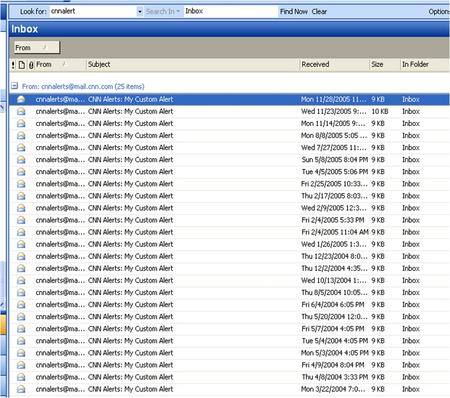It seems fitting to write about email management in April since it is Records and Information Management Month. A couple of years ago, I attended a conference where another archivist declared that email was dead. I disagreed then, and still do, for now. More recently, in November, Facebook founder Mark Zuckerburg stated that the company doesn’t think that the “modern messaging system is going to be e-mail,” as he announced a new Facebook message service. But even as social media sites such as Facebook and Twitter continue to see growth, so does email use. The number of email accounts, according to projections from the research company Radicati, will grow from 2.9 billion in 2010 to more than 3.8 billion by 2014. Accordingly, the email messages and attachments that have replaced handwritten correspondence in both our personal and business lives, in many cases, will continue to require some organization.

A 2010 study by comScore found that while fewer people in the United States are visiting web-based email sites such as Gmail and Hotmail (this does not include Outlook, Entourage, GroupWise, etc.), the number of people using mobile phones to check their email is growing. The Pew Internet & American Life Project reported in 2010 that even though text messaging has greatly increased among teens, they still are using email, too. Managing email is a challenge for everyone. The Smithsonian Institution Archives and the Rockefeller Archive Center collaborated on a three-year email preservation project that explored the management practices of email users in their work. Interviews conducted showed strategies that varied greatly, from people who were highly organized and purged unwanted emails regularly, to others who keep thousands and thousands of messages and attachments in one folder. One director said his office did not have time to manage email but did not think it was a problem because storage was cheap. But even if it is, all email does not need to be retained. Do you really want conduct a search of 70,000 messages dating back to 2005 to retrieve a message about Aunt Sally’s chicken salad recipe from the family reunion? With this in mind, we’ve put together some basic guidelines for helping you to manage your work and personal email.
Issues to keep in mind at the workplace:
- Use appropriate and meaningful subject lines.
- Your email could be a record that may need to be retained temporarily or permanently depending on its contents and your industry or office’s practices/disposition schedules. Consult with appropriate staff for policies and guidance.
- Don’t consider your email to be private.
- Email can be subject to legal discovery.

An organized email account at home or work can be achieved in a variety of ways.
- Take time to weed or delete email messages and/or attachments you no longer need. This can include earlier messages that are captured in later emails, junk/spam, outdated announcements, and advertisements. Again, in the workplace consult with appropriate staff for guidance to ensure you do not delete official records.
- Check the Junk/Spam folders and delete those messages. Not all email applications are set to automatically delete junk.
- Delete messages not needed in the Sent folder.
- Empty the email application’s Trash folder.
- Create folders or labels to file your messages. Some email applications also have the ability to label by color.
- Use filters or set up rules to automatically place a message in a specific folder once it has been received or sent. This option is available in some email programs.
- Postpone or unsubscribe from listservs if you are unable to check your email for an extended period.
Email uses and management practices will, no doubt, continue to change as other social media tools are developed. (I don’t think we will see minutes from a business meeting appearing on a Facebook Wall anytime soon.) Do you have email management tips you would like to share? Your thoughts and comments are welcome.
Produced by the Smithsonian Institution Archives. For copyright questions, please see the Terms of Use.

Leave a Comment